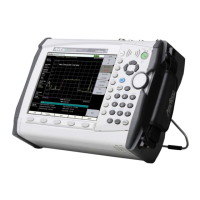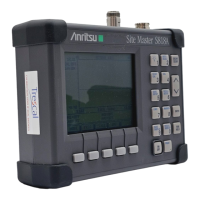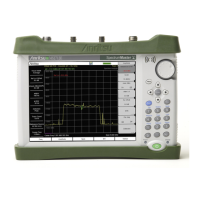Glossary of Terms
MS20xxC UG PN: 10580-00305 Rev. L H-5
dB : Decibel or deciBel (dB) is a logarithmic ratio of the difference between
two values (a logarithm ratio is equal to 10 times). dB is a unit for
measuring relative power ratios in terms of gain or loss. The units of dB
are expressed in terms of the logarithm to base 10 of a ratio and
typically are expressed in watts. For example, a -3 dB loss indicates a
50% loss in power; a +3 dB reading is a doubling of power; 10 dB
indicates an increase (or a loss) by a factor of 10; 20 dB indicates an
increase (or a loss) of a factor of 100; 30 dB indicates an increase (or a
loss) by a factor of 1000. Common values of dB expressed in ratios: 0 dB
= 1:1, 10 dB = 10:1, 20 dB = 100:1, 30 dB = 1000:1, -30 dB = 0.001:1 [or
(1/1000):1].
dBc : Decibels referenced to the carrier (dBc) is a technique for expressing a
power measurement in logarithmic form using the carrier power as a
reference. The units are used to describe how far down signals and noise
are relative to a known signal. Typical use of this term is to describe
spurious signals and noise compared to a desired transmit signal.
dBm : dBm is an absolute measurement of power relative to 1 milliwatt. In
other words, dBm is a decibel value referenced to a milliWatt (dBm).
This is a technique for expressing a power measurement in logarithmic
form using 1 mW as a reference. dBm is a decibel ratio (log 10) of Watts
(W) to one milliwatt (1mW). dBm, therefore, represents absolute power.
Examples are: 0 dBm = 1.0 milliwatt, 10 dBm = 10 milliwatt, 30 dBm =
1000 milliwatt = 1 watt.
DHCP : Dynamic Host Configuration Protocol (DHCP)
DSP : Digital Signal Processing (DSP)
DTF : Distance-To-Fault (DTF) is the distance from the instrument output
connector (or the end of a test lead) to a problem area, as indicated by a
peak in the displayed signal. DTF measures the location and reflection
size of impedance mismatches. This is typically a diagnostic
measurement, not a pass/fail judgement measurement. DTF is used to
identify and locate faults within an antenna system when the system is
failing to meet the specified return loss or VSWR limits. DTF is also
useful to verify the total length of a coaxial cable assembly.
FFT : Fast Fourier Transform (FFT) is an efficient algorithm to compute the
Discrete Fourier transform (DFT) and its inverse. FFTs are of great
importance to a wide variety of applications, from digital signal
processing to solving partial differential equations to algorithms for
quickly multiplying large integers.
